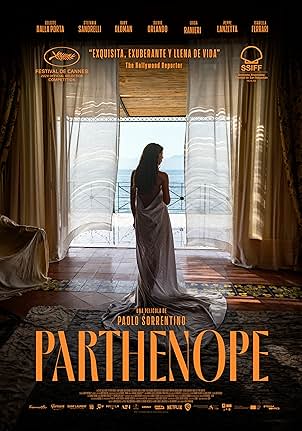Sister Sarah Joan: You clearly love Sacramento.
Christine ‘Lady Bird’ McPherson: I do?
Sister Sarah Joan: You write about Sacramento so affectionately and with such care.
Christine ‘Lady Bird’ McPherson: I was just describing it.
Sister Sarah Joan: Well, it comes across as love.
Christine ‘Lady Bird’ McPherson: Sure, I guess I pay attention.
Sister Sarah Joan: Don’t you think maybe they are the same thing? Love and attention?
Set in Naples, “Parthenope” (2024) starts in 1950 shortly before the titular character is born and ends in 2023. The daughter of affluent parents, sister to a fragile brother, Raimondo (Daniele Rienzo, who resembles Timothee Chalamet), and a captivating figure to most heterosexual men with eyes, Parthenope (Celeste Dalla Porta) meanders through life. After tragedy strikes, Parthenope tries to find meaning in her academic studies but still goes on numerous sidequests that capture her attention. What is she thinking? A cynical person would say she is debating whether to devote her life to beauty or brains, but the real answer is the ambiguous origin story behind the reason for her choice.
Italian director Paolo Sorrentino explores the path not chosen if he was a hot, young woman whose milkshake brings all the boys to the yard. He studied at the University of Naples before choosing film, and “Parthenope” makes the argument that if he had just chosen anthropology, he could have had the best of both worlds. It recalls the exchange quoted above in “Lady Bird” (2017) between Saorise Ronan’s character and Sister Sarah Joan. Love is observing Naples and its people without judgment then conveying it to others just as a filmmaker does. Does Sorrentino succeed?
If the moviegoer is not from Naples or attracted to women, maybe not, but they will not care because “Parthenope” is so gorgeous filled with numerous vignettes tied together with some gossamer ribbon held together through the power of Dalla Porta’s performance in her first credited big screen role. When she first appears, Parthenope is supposed to be eighteen, and Porta is so self-assured and self-possessed that it strains the suspension of disbelief that she could be an adolescent. It is like television series where actors in their twenties and thirties play all the teenagers. As the film progresses, and the protagonist gets older, Dalla Porta allows a glimpse of the normal woman behind the siren-like woman. Otherwise, the camera constantly ogles her and offers little to no sense of her interiority. Stefania Sandrelli plays the older Parthenope, and her version of that character would be the one that would appeal to women because she is a person with friends, colleagues and a community. Instead, Sorrentino prioritizes the version who entrances men.
When Sorrentino imbues Parthenope with the skill to make quick, clever comebacks and the outward trappings of a nerd, it feels like a shield against criticism that she is just an object. For those feeling generous, she is like a Dickens character that more interesting people orbit because they are drawn to her beauty. The exception: her father figure, Devoto Marotta (Silvio Orlando), a stern professor who is secretive about his life outside of school because he is sensitive and protective of an often gossiped about family member. In a desert of attraction, he is a much-needed reserve of water and her most meaningful relationship.
While it is relatable how young people’s lives often appear random, and most relationships are less significant than they initially seem then fall to the wayside, “Parthenope” does not feel as if it was aiming for a universal truth. It feels like a more cohesive “Megalopolis” (2024) where you are willing to go along for the ride, and may leave with a vague sense of what the movie was supposed to be, but the end result is kind of a mess and baffling because it is hard to believe that no one took Sorrentino aside, especially a woman, and encouraged one more draft. At its more sordid moments, it feels Kubrickian with Parthenope toying with the idea of incestuous threesomes, hookups with wealthy men, witnessing a young couple have sex in front of a crowd or playing one night in heaven with one lucky older man. The latter character seems to favor Sorrentino’s aesthetic against pornographic detail because everything is very tasteful: nudity, sex and death. Apart from the young couple, Sorrentino does not linger or omits showing sex or nude bodies entirely. There is a lot of distance or well-placed objects. Yorgos Lanthimos would not approve, and Emma Stone would start yawning.
Most of the male characters are boring, and their sauce does not match her sauce. Parthenope enraptures them. They shoot their shot. She gives them a shot or doesn’t. The exception is the gay American author John Cheever (Gary Oldman), who meets Parthenope in 1968. Sorrentino gives him some monologues, but they do not quite work since the impact gets lost as Cheever struggles to stay coherent while drowning in a booze-soaked haze. Why Cheever? The real-life Cheever, who was bisexual, interviewed Sophia Loren in Naples while she was filming “Questi fantasmi” (1967), English title “Ghosts, Italian Style,” also known as “The Best House in Naples.” Oldman is usually a reliable staple if you want to elevate a film, but not this time, especially not so soon after the release of “Queer” (2024), which has zero connections to Naples and would ordinarily be irrelevant, but Daniel Craig now dominates the field as an altered American author wandering the world.
The most frustrating aspect of “Parthenope” is that it never occurs to Sorrentino to write ordinary, platonic women. Flora Malva (Isabella Ferrari), an acting coach, cannot resist shooting her shot, and Greta Cool (Luisa Ranieri), an actor reduced to making local appearances for money, is more of a lesson to Parthenope not to over rely on her beauty although Greta Cool’s crash out is so spectacular that if Sorrentino gave her a sequel, buying a ticket would be a no brainer. Both women could appear in “The Substance” (2024), and it would be a seamless transition. They are women living in the past suffering from the loss of their outward talents. Still, they were a welcome break from the monotony of men lined up to get Parthenope’s attention.
People with knowledge of “The Odyssey” will derive more meaning from the plot if they recognize that Parthenope is not just named after a region, but a suicidal siren. One of the characters is implied to commit suicide off screen, and “Parthenope” was dedicated to Luca Canfora, the film’s costume designer, who died under mysterious circumstances on September 1, 2023 as filming started to wrap up. His body was found in the ocean. It is an unfortunate real-life example of life imitating art. By offering this fact. IMDb contradicts itself because it simultaneously credits two other costume designers in the actual cast and crew listing. Regardless of who is responsible for what, there are so many memorable looks, including a barely there, spaghetti strapped dress worm on New Year’s Eve, 1968 or the sacrilegious arrangement of the treasure of San Gennaro. The latter felt as if could have worked in “The Queen of the Damned” (2002).
The surreal elements do not work though they convey a clear meaning about what is truly beautiful is the innocence and purity of the soul. For Parthenope to witness this exclusive, shielded from the world figure and the ability to appreciate him is a passing a baton of responsibility owed to the world of truly seeing things as they are. The figure’s size, which may be a symbol of responsibility, skin color and mentality, which evokes sheltering, innocence and fragility, seems too sensational and abrupt as if Sorrentino suddenly wanted to try his hand at being Terry Gilliam. Spanish filmmakers dominate the field of magical realism because they understand that the fantasy elements must be blended into the quotidian world in a way that it would feel foolish not to believe that the mythical elements were real. They must be cut from the same cloth and atmosphere. If earlier elements were similar to this CGI creation or this figure felt as if his appearance stemmed from practical effects, it would feel less precious and not stand out like a sore thumb instead of a pivotal turning point of maturity for the protagonist.
“Parthenope” is an undeniably gorgeous movie, but it feels like a throwback to a day and age where women existed to only relate to men and had no independent dreams and desires. The titular character never feels like a real whole person, but a fantasy gussied up to be more than a looker though appearance is her leading trait. While everyone does their best, some men just cannot write women, and Sorrentino is one of them. Just say nope to “Parthenope.”





